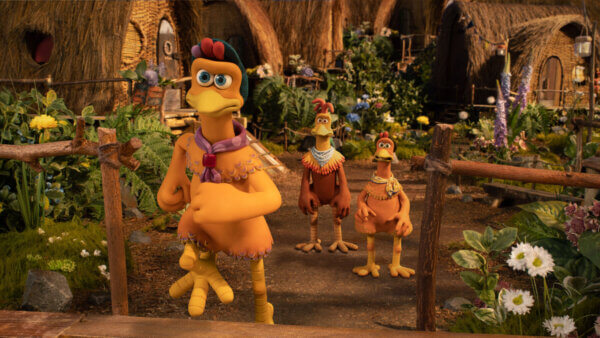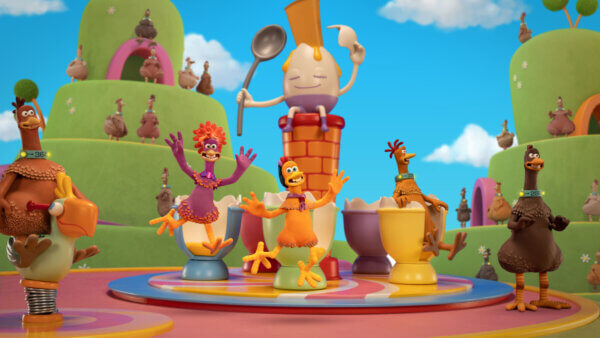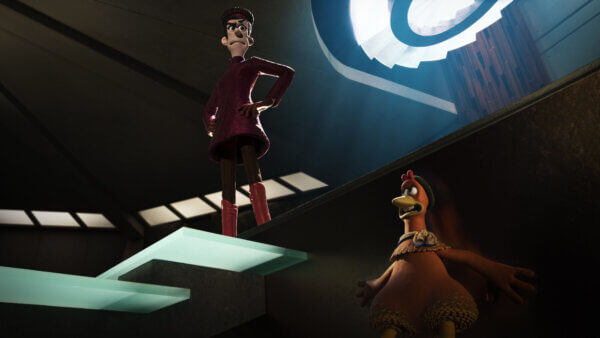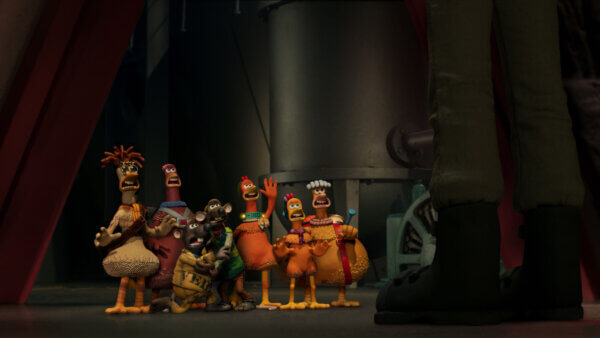Chicken Run: Dawn of the Nugget | Interview with Suzy Fagan Parr
In the intervening 23 years between Chicken Run (Dir. Peter Lord/Nick Park, 2000) and Chicken Run: Dawn of the Nugget (Dir. Sam Fell, 2023), Aardman has changed a lot. Their practices have evolved, with CGI playing a heavier role in their productions, franchises like Shaun the Sheep have sprung up and become core aspects of their identity, and their sets have expanded to include miniature (C scale) and expansive (A scale) locations. Through all that change, Suzy Fagan Parr is a member of a core crew of animators who were there for the studio’s very first feature.
Having worked on 2000’s Chicken Run as a key animator, Suzy returns to the flock as an additional sequence director. Skwigly caught up with Suzy at the Manchester Animation Festival to chat about the emotional experience of returning to these characters, the changing nature of Aardman and blending CG with stop motion.
How have you found the response to the film?
I did see it at the BFI last month and I was really excited by how everybody was laughing their socks off. There was an energy in the room that was really positive and I think – because the crew was there as well, and they’re the toughest audience a lot of the time – that the audience really lifted the room and the whole crew. It was really good.
How did your role differ from working on the first Chicken Run to the sequel?
On the first Chicken Run, I was a key animator, which was part of the core team that brought the characters to the fore, but on this one I was also an additional sequence director. During my time on the film, I was, pardon the pun, under the wing of Sam [Fell] and so everything that I did would be run by him. But I was very much left to my own devices to set up shots and be part of the director team. I was animating as well but it was a bit more of, when I could animate, rather than being a pure animator.
How much of a burden is having those two roles?
It was actually surprisingly difficult, because when I was animating I kept being disturbed to go and look at the shot, then set up sets and things, so it was actually quite difficult if I was on a long shot, so I tended to be quite protected from that during the shoot itself. But towards the end, when things got a little bit more free for me, I got thrown in the deep end with the animation. It depended on what I had on my plate, how much I was animating.
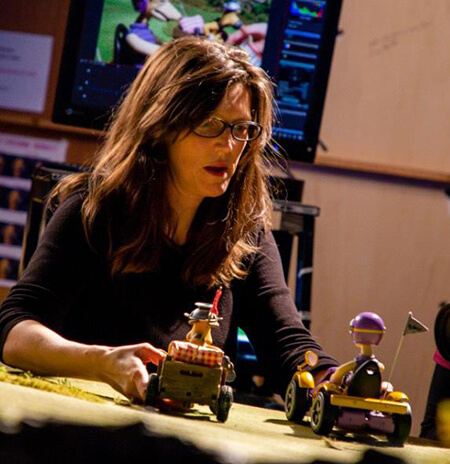
Image courtesy of Suzy Fagan Parr
Having animated Ginger in the first movie, what were the emotions like knowing you were returning to this character?
One of the things I could not believe was how much I remembered from the first film. You think you come to the end of a project, and you move on to the next one and all the information goes, but actually 20 years later, touching the puppet I remember things like how her cheeks have to sort of go out at exactly the right angle, and like how her feet stand together when she’s posed. I could remember all these little nuances, but that was really useful for the team because there were a few of us that had been on the first one and it just meant that we could really get everyone up to speed much quicker.
What was the biggest difference between the two productions?
The biggest differences were the use of two scales and so having multiple passes for a single shot, and also how we used CG as supporting those bigger shots where the cast was greater. I mean, in terms of the difference in animation, stop motion is the same now as it’s always been. In that way, there was no difference, it was the situation that they were in that was different.
How different does Aardman as a whole feel?
It’s much bigger now, the crew is much bigger and we can tell much more sophisticated stories. That’s probably the biggest thing. I suppose what’s also different is that there’s a really nice age group now. When we first started, we were all young and in it together, and then gradually the more experienced of us, a lot of us are still there and so the younger ones have got that to draw on.
Do you feel like the identity of the company has shifted?
Aardman is very much still Aardman, but I think the experience that we’ve had doing eight feature films brings with it that ability to be more ambitious and have confidence that we might not have had earlier in early days, not that you can really tell from Chicken Run. But it was a learning experience for all of us. Now it’s like, oh yeah, we know that because we’ve done it in this film or that film. And so the whole crew is a bit more experienced.
Was the biggest lesson that you learned during those years in between that you’ve applied this time around?
It’s confidence, isn’t it? But sometimes experience can complicate your reaction to something as well, because you might overthink it. Whereas in early days, you might have just done it blindly without knowing what the consequences might be. But I think there’s a balance there. The other things we’ve learned, I think it’s knowing what is possible. So on Chicken Run, maybe we would be a little bit more guarded, for example, we were all unsure about how the plasticine would look, how clay would look projected on the screen. Whereas over the years, we realised that clay looks lovely when projected big because it gives that real human touch.
Was there a conversation about the balance between using CG versus stop motion?
It was a constant conversation. Originally, it would be that all the background; the extended cast would be CGI and then the foreground characters would be stop motion. But because we didn’t make physical, C scale puppets, there were times when we would normally have animated in C scale and we had to use CG. They were operating on a C scale set but they might have been a bit closer up. But actually, the digi doubles that we used were so close to the puppets, I mean, scary close.
How do you naturally transition between stop motion and CG?
It’s a suspension of disbelief. The lovely thing is your eye will get used to it. If we were animating on singles all the way through and we suddenly changed to doubles, you would suddenly notice, but because we start off in doubles, your eye actually gets used to it. Your persistence of vision makes up the gap, our brains adjust to what we’re seeing.
In your talk you mentioned that with stop motion, you can’t go back and change things. Is that mode of storytelling scary?
Oh, definitely. There’s almost a little bit of jitters in your stomach when you show up because you have no real idea how it’s gonna go. All you can do is prepare for it, look over your brief of what Sam [Fell] wanted, get all the sticking points smoothed out when you’re doing your block through, which is like a dress rehearsal off the shot where you don’t animate every move. So you need to know what you’re doing. Some animators do minimal amounts of preparation, they just hope for the best and there’s a lovely magic to that style. Then other animators will be very technical and have it all marked down exactly where they want to be, how many frames it’s going to take them to get there. It depends on your attitude.
Is the pressure different when you’re a key animator versus when you’re a director looking at the movie from a bird’s eye view?
I think the jitters are just somewhere else. Also, the director has to really trust the animator. The director themselves has to go, ‘I hope for the best that the animator understands.’ But sometimes it happens that it doesn’t quite hit the spot or whatever, and then the director will have to decide if it misses the point of the shot enough to reshoot, but that wouldn’t happen very often. It’s about 97% we got the first take. We do have options to tweak it, if a shot needs a bit of a re-time, we can do that in the edit afterwards. Generally, we try to keep away from that. It’s not a popular thing with the animators, because you get very protective about your own animation.
That’s the Aardman way though right? You’d be teaching interns to expect moments like that.
You do get used to it because it is part of the process. I guess everybody’s at a certain experience level when they are entrusted with a shot. There’s going to be a point in every animator’s career where they step up but especially on features we’ve got to know that those animators are confident enough to achieve the effect we want. That’s why doing series work and commercials works really great to get everyone up to speed.
What’s the most ambitious sequence in the film?
It’s got to be the money shot where we see the chicken island revealed for the first time. I think it’s a nearly 40 second shot and it’s all camera movement and characters coming in and out shot. Their actions have to come online just as camera reveals them and then the camera drifts off and it reveals the chicken island at large. We’ve got the CG chickens to populate it, hundreds of background chickens. That one took 18 weeks to shoot.
How do you communicate the sense of scale of the new chicken farm?
The story on the first film was obviously all on that chicken scale, they were in their chicken run with chicken huts built for chickens. Even though it might look human scale in some ways, that was because we were with the chickens. On this one, they are going into the human world. So that was why there was so much complication and working out and planning about what would have to be built in A scale and C scale. We’ve got these two fundamental scales and then it’s just a matter of laying up and comping and adding to it with virtual production and VFX imaging, just being able to recreate that world in CG to extend it, but without losing the essential stock frame-ness of the movie. We did that by the VFX department being so amazing and knowing how to keep the texture looking like stop motion, but with the flexibility of that scale.
How do you make these characters still feel like themselves after 23 years?
We had to keep them as we know them, but also move them in such a way so there’s quite a distinct difference between the way they are in the first film and the way they are in this film. What we’ve managed to create with them breaking in, that being the mood of the film, is that they’re not trying to escape, they’re not the victims anymore. I think it’s in the writing, obviously, and then it’s also in the new technology and the fact that we can put them into a different environment creates that contrast from how it was and how it is now.
Which Aardman property would you like to see a sequel to?
I loved The Pirates. I would love to see Pirates get a sequel. I just thought it was funny, it was charming, the animation was great, the sets are incredible and I think it really is worthy of a sequel.
Chicken Run: Dawn of the Nugget is available on Netflix now


